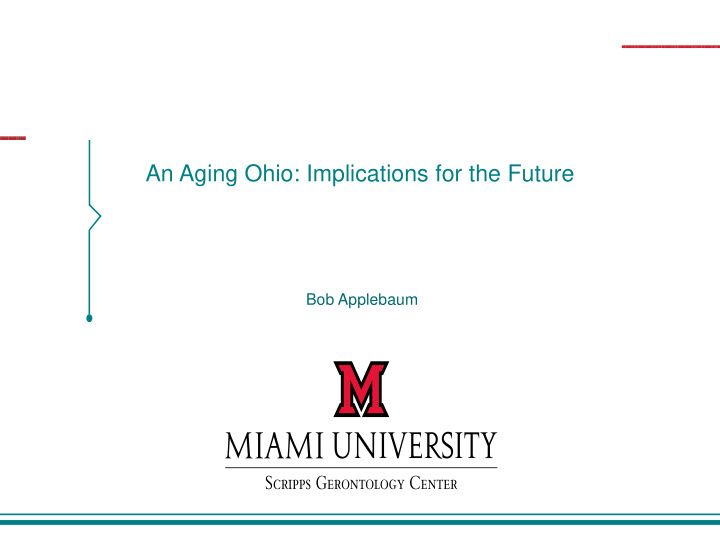



An Aging Ohio: Implications for the Future Bob Applebaum
Ohio’s Aging Population (2015-2030) Ohio Ohio Ohio % City of Hamilton Age Change Cincinnati County Group 2015 2030 2015 – 2017 2017 2030 298,960 808,700 All 11.61 11.65 0.3 Million Million Ages 2.6 52,400 169,000 60 and 3.1 18 over Million Million 1.84 2.4 29 35,700 117,000 65 and Million Million over 481,800 596,900 80 and 24 over 85 plus 5,714 18,206
An Aging Am erica: Are You Aging? • Gravity more pow erful than kryptonite • You now look like your parents • You have given up hope of being a professional athlete • You have given up hope of finding a sensitive partner • You need to rely on a junior high school kid to meet your communication needs.
Com ponents of a Good Old Age (Variation R Us) • Income Security • Health/Health Care • Long-Term Services and Supports • Housing • Family Support • Civic Engagement and Employment • Age Friendly Community – outdoor spaces, information, social participation
Retirem ent Incom e • Maximum Soc Sec benefit in 2018 is $2788 • Avg. monthly Soc Sec benefit $1,342 • 40% retirees rely primarily on Soc Sec • Less than half of today’s workforce has a private pension • Majority of older people do own their own homes (in Ohio 80%) • Median savings for 60-64 age groups in U.S.is about $15,000 Avg above $200K
Health Behaviors Behaviors Ohio U.S. Rank Smoking 10.6 8.7 41 Excessive drinking 6.0 7.1 19 Obesity 29.7 28 32 Physical inactivity 34.8 29.5 43 Frequent mental distress 6.2 7.3 11
Aging in Ohio: Health Conditions, 65 plus Health conditions Ohio U.S. Ranking Diabetes 24 22 38 Arthritis 57 52 44 Hip fractures per 1000 5.8 5.7 32 Falls (last 12 months) 28.8 29.5 16
Ohio Health Use and Access 65 Plus Health Access & Use % Ohio U.S. Ranking Drug Coverage 89 87 1 Dedicated Health Provider 95 94.5 23 Low Care NH Residents 11.7 11.7 27 30 day Hospital Readmits 15.1 14.9 35 Preventable Hospitalizations (per 1000 admits, Medicare) 57 49.4 42
Risk of Social Isolation • Six factor risk of social isolation Ohio ranks 33/50 (America’s Health Rankings) • Unmarried 46% (Bottom 10) • Poverty 8.1% (Top 10-20) • Disability 35.1 (21-30) • Indpt Living Diff 14.7% (21-30) • Living Alone 29.1 (Bottom 10) • Food Insecurity 15% (31-40) • Volunteerism 26% (20-30)
National Long-Term Services Num bers • 6 million older people with disability– will more than double by 2040 • Long-term services about one-third of Medicaid expenditures (Ohio 36%) • Medicaid about 22% of state budgets (Ohio 24%) • 63% of Medicaid LTC funds to nursing homes– varies by state • Two-thirds of residents now on Medicaid
Are Individuals Prepared for Long- Term Disability? • What is disability? Moderate shopping, getting to the doctor without help– Severe help with dressing or bathing • Will it effect me? 65 and older with some long-term disability 28.4% 65-74 20.2% 75-84 26.9% 85 plus 42.4% Women higher rates than men 4% of Ohioans over age 40 have LTC insurance Already talked about income and savings rates for older population
Ind iv id ua ls Prep a red : W ha t Clerm ont County Boom ers Think About Their Aging Liv es. (CSS a nd AARP surv ey ) • 70% expect to stay in this area • 79% rated staying in current residence as extremely or very important • 25% expect to move from current place in next ten years • 89% intend to drive for their whole life • 47% would need to move if could not drive • 20% expect to live alone most of their retirement years • Will exercise daily 78%
Housing and Living Arrangem ents/ Decisions • Where do I want to live? • With whom? (Who is likely to care for me?) • What services are accessible to me in my proposed community? • What do I need to do to make housing and living arrangements happen, and when? (Home modifications? Move?) • What is the effect of my decision on others? 18
Fam ily and Aging • Informal care provided an estimated $450 billion in long-term services • No time in history has more care been provided by family • But the world has changed– living longer, more two person working households, fewer children • Successful LTSS strategies almost always involve family
How Can Ohio Better Respond to the Growing Long-Term Services Challenges? • Unprecedented growth in the older population • Majority of Ohioans not prepared for a long-term disability either financially, environmentally, socially • Medicaid—the default for the majority of long-term service recipients. • Ohio’s older population is less healthy.
Strategies for Ohio • We need a range of solutions and an array of stakeholders to respond. • Individual level -- Responsibility for individual long- term planning • State Governmental examples– prevention programs, public/prvt partnerships • LTSS Provider examples —Identify strategies to improve effectiveness & efficiency • Business Community examples— Develop innovative technology, more flexible workplace • Local Community examples —Implement efforts to become a more age friendly community
Policy and the Future • Even with changes the current system is simply not sustainable. • Short-term window where “boomer growth” remains small, before the major increase. • The current system was never designed-- it just happened– Meaningful change is very slow. • We often have policy changes with unplanned consequences. Hospital reform meant a new nursing home.
Contact info 23 Bob Applebaum Applebra@Miamioh.edu Scrippsaging.org (Scripps web site)
Recommend
More recommend